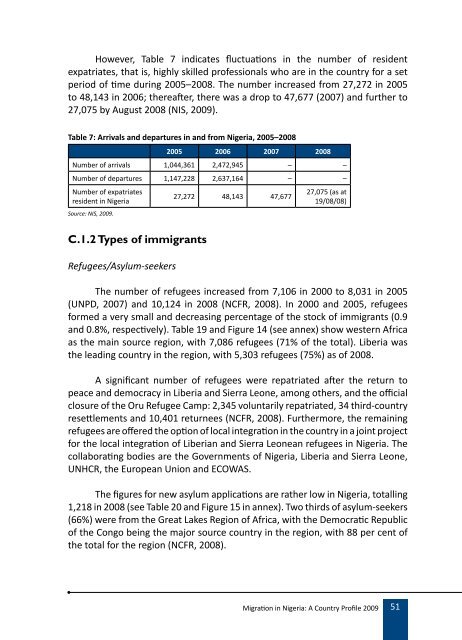Migration Profile on Nigeria - IOM Publications - International ...
Migration Profile on Nigeria - IOM Publications - International ...
Migration Profile on Nigeria - IOM Publications - International ...
You also want an ePaper? Increase the reach of your titles
YUMPU automatically turns print PDFs into web optimized ePapers that Google loves.
However, Table 7 indicates fluctuati<strong>on</strong>s in the number of resident<br />
expatriates, that is, highly skilled professi<strong>on</strong>als who are in the country for a set<br />
period of time during 2005–2008. The number increased from 27,272 in 2005<br />
to 48,143 in 2006; thereafter, there was a drop to 47,677 (2007) and further to<br />
27,075 by August 2008 (NIS, 2009).<br />
Table 7: Arrivals and departures in and from <strong>Nigeria</strong>, 2005–2008<br />
2005 2006 2007 2008<br />
Number of arrivals 1,044,361 2,472,945 – –<br />
Number of departures 1,147,228 2,637,164 – –<br />
Number of expatriates<br />
resident in <strong>Nigeria</strong><br />
27,272 48,143 47,677<br />
27,075 (as at<br />
19/08/08)<br />
Source: NIS, 2009.<br />
c.1.2 Types of immigrants<br />
Refugees/Asylum-seekers<br />
The number of refugees increased from 7,106 in 2000 to 8,031 in 2005<br />
(UNPD, 2007) and 10,124 in 2008 (NCFR, 2008). In 2000 and 2005, refugees<br />
formed a very small and decreasing percentage of the stock of immigrants (0.9<br />
and 0.8%, respectively). Table 19 and Figure 14 (see annex) show western Africa<br />
as the main source regi<strong>on</strong>, with 7,086 refugees (71% of the total). Liberia was<br />
the leading country in the regi<strong>on</strong>, with 5,303 refugees (75%) as of 2008.<br />
A significant number of refugees were repatriated after the return to<br />
peace and democracy in Liberia and Sierra Le<strong>on</strong>e, am<strong>on</strong>g others, and the official<br />
closure of the Oru Refugee Camp: 2,345 voluntarily repatriated, 34 third-country<br />
resettlements and 10,401 returnees (NCFR, 2008). Furthermore, the remaining<br />
refugees are offered the opti<strong>on</strong> of local integrati<strong>on</strong> in the country in a joint project<br />
for the local integrati<strong>on</strong> of Liberian and Sierra Le<strong>on</strong>ean refugees in <strong>Nigeria</strong>. The<br />
collaborating bodies are the Governments of <strong>Nigeria</strong>, Liberia and Sierra Le<strong>on</strong>e,<br />
UNHCR, the European Uni<strong>on</strong> and ECOWAS.<br />
The figures for new asylum applicati<strong>on</strong>s are rather low in <strong>Nigeria</strong>, totalling<br />
1,218 in 2008 (see Table 20 and Figure 15 in annex). Two thirds of asylum-seekers<br />
(66%) were from the Great Lakes Regi<strong>on</strong> of Africa, with the Democratic Republic<br />
of the C<strong>on</strong>go being the major source country in the regi<strong>on</strong>, with 88 per cent of<br />
the total for the regi<strong>on</strong> (NCFR, 2008).<br />
<str<strong>on</strong>g>Migrati<strong>on</strong></str<strong>on</strong>g> in <strong>Nigeria</strong>: A Country <str<strong>on</strong>g>Profile</str<strong>on</strong>g> 2009<br />
51

















